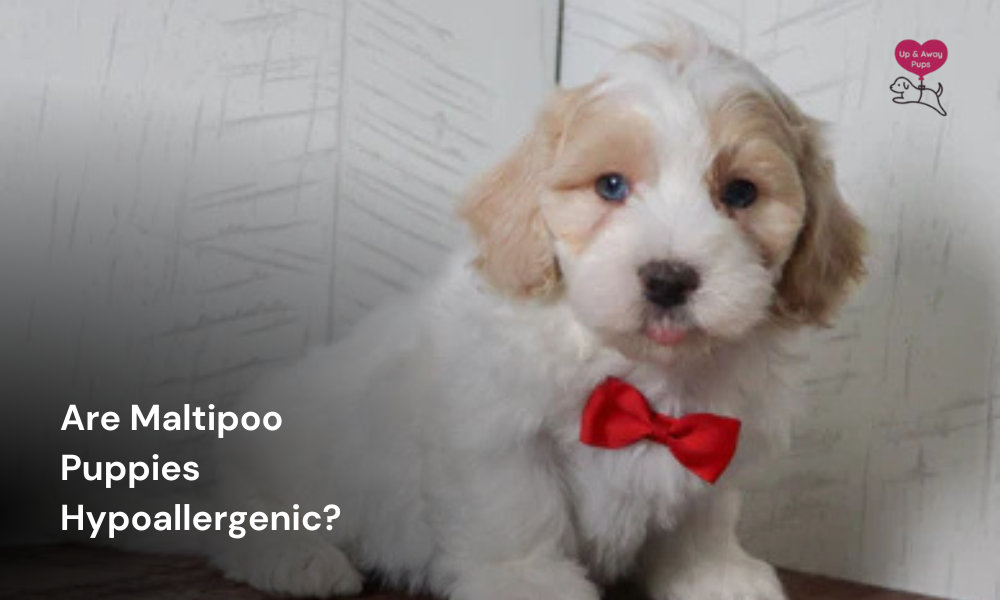Are Maltipoo Puppies Hypoallergenic?
Wondering if Maltipoos are hypoallergenic? This guide breaks down what "hypoallergenic" really means and how Maltipoo coat traits impact allergy sufferers. While no dog is truly allergen-free, Maltipoos shed less, making them a better option for sensitive individuals. You’ll also find practical tips on grooming, cleaning, and creating allergy-safe zones, plus FAQs on asthma, coat types, and more. A must-read if you're considering a Maltipoo but worried about allergic reactions.
The adorably charming Maltipoo has gained major popularity for its affectionate nature and a puppy face that will have you speaking gibberish. If you're curious why they're such a beloved breed, check out their Maltipoo personality traits to see what makes them perfect pets. However, since they are a mix of Maltese and Poodle, we often find people asking us if Maltipoos are hypoallergenic and if those with allergies can bring them home. Since the question isn’t a simple yes or no, let’s dive deeper into this topic so we can understand it better.
Understanding Hypoallergenic Dogs
Let us first understand what the term hypoallergenic means. This term is used to describe those dog breeds which are less likely to trigger allergic reactions in sensitive individuals that have dog allergies. Now, the keyword here is less likely. No dog, no matter what anyone says, is ever truly, entirely hypoallergenic. Studies have shown that so-called hypoallergenic dogs may not have significantly lower allergen levels than other breeds
You see, most people are under the impression that allergies are triggered by a dog’s fur, which isn’t telling you the entire picture and is rather misleading. Allergenic reactions are triggered by the dander, that is, dead skin cells, saliva, and urine. The primary culprit here is dander, as it gets carried by fur, but also becomes airborne and, upon being inhaled by allergenic humans, triggers a reaction.
Maltipoo Coat Characteristics
Well, without getting all science teacher about it, every dog, including Maltipoos, inherit their coat traits (and just traits in general) from both parents, which happen to be the Maltese and Poodle in this case. Now, what makes the question “are Maltipoos hypoallergenic” so common amongst dog lovers is because, genetically, both of these dogs are quite low-shedding and Poodles are often referred to as hypoallergenic. So, naturally, the offspring—the Maltipoo here—also have hair that sheds less compared to other breeds.
Less shedding means less dander released into the environment, making them less likely to trigger an allergic reaction and making them more suitable for allergy sufferers compared to other dog breeds. If you're curious how they compare to similar breeds, check out our Maltipoo vs Poodle and Maltipoo vs Havanese comparisons.
However, do keep in mind that while Maltipoos may shed less dander due to their coat type, they still produce it. The amount of dander can vary among individual dogs, so the risk is still present—merely reduced.
Individual Reactions Vary
Allergies aren’t so straightforward, and allergic reactions are highly individual. Some people might be able to tolerate Maltipoos, but others might experience symptoms. So, in this situation, the best thing to do is spend time with the Maltipoo pup. Hang out with them, see if any symptoms get triggered before you bring them home.
Managing Allergies with a Maltipoo
If you’ve already fallen in love with a Maltipoo and have made up your mind about getting one, whilst there is no way to eliminate allergies, memorizing the Maltipoo Grooming Guide is the best way to manage them:
Regular Grooming: Surprise, surprise! Did you know regularly bathing and brushing can reduce the amount of dander? Well, yes, it does. Use shampoos designed to moisturize the skin to prevent dryness, keep your dog hydrated, and dander production should slow down.
Clean Your Space: There is no escaping dog hair in your home if you have a dog, but it can be managed fairly well. Paired with regular grooming, if you’re particular about cleaning your home, including vacuuming carpets and upholstery, you can remove pet allergens to a great extent. In fact, using air purifiers with HEPA filters also helps.
Pet-Free Zone: Sometimes, you just need a space away from your pup and their fur, and there is absolutely no need to feel guilty about it. Establish an area within your home wherein your Maltipoo is not allowed, to make that your safe space. This is much needed for all allergy sufferers.
Consult a Professional: If allergies are a concern, you might want to get some medical assistance. They can provide personalized advice and even offer treatment like immunotherapy to help manage the symptoms better.
Conclusion
So, long story short, Maltipoos are generally considered to be hypoallergenic and a good option for dog lovers that suffer from allergy due to their low-shedding coat. Thank you, Poodle parent. However, again, we reiterate, no dog is ever truly hypoallergenic and individual reactions vary to a great extent. We do not recommend bringing home a pup before you’ve spent some time with them and seen how your individual allergic response is towards them. Use the strategies we mentioned to reduce allergens within your home so you can create a more comfortable space for everybody.
FAQs
Do Maltipoos Trigger Asthma or Respiratory Conditions in Sensitive Individuals?
Yes, they can. While Maltipoos produce less dander than many breeds, they still produce proteins in their saliva, skin, and urine that can trigger asthma and other respiratory issues in sensitive individuals. It's not just about fur—it’s about how your immune system reacts to those proteins. If you have a history of asthma that's worsened by pet allergens, consult your doctor before bringing home a Maltipoo.
Is There a Difference in Allergen Levels Between Maltipoo Puppies and Adults?
There can be. Puppies usually have softer, finer coats, which might produce less dander early on. But as they grow, their adult coat develops—often curlier, denser, and possibly more prone to trapping dander. Plus, hormonal changes and skin development can affect allergen levels over time. It’s not unusual for someone to be fine around a puppy, only to develop symptoms as the dog matures.
Do Different Coat Types in Maltipoos Affect How Hypoallergenic They Are?
Yes, they do. Some Maltipoos inherit more of the Poodle's curly coat, which tends to trap hair and dander better—this may reduce allergen spread in the home. Others get a straighter or wavier coat more like a Maltese, which might shed a bit more. If allergies are a concern, a Maltipoo with a tighter curl might be the safer bet, but there’s no guarantee.
Related Articles
If you want to explore more information about the Maltipoo breed, check out the article below for a comprehensive overview;
• Can Maltipoos Swim? Essential Tips for Safe Water Fun
• Do Maltipoos Bark a Lot? What to Expect & How to Manage It


